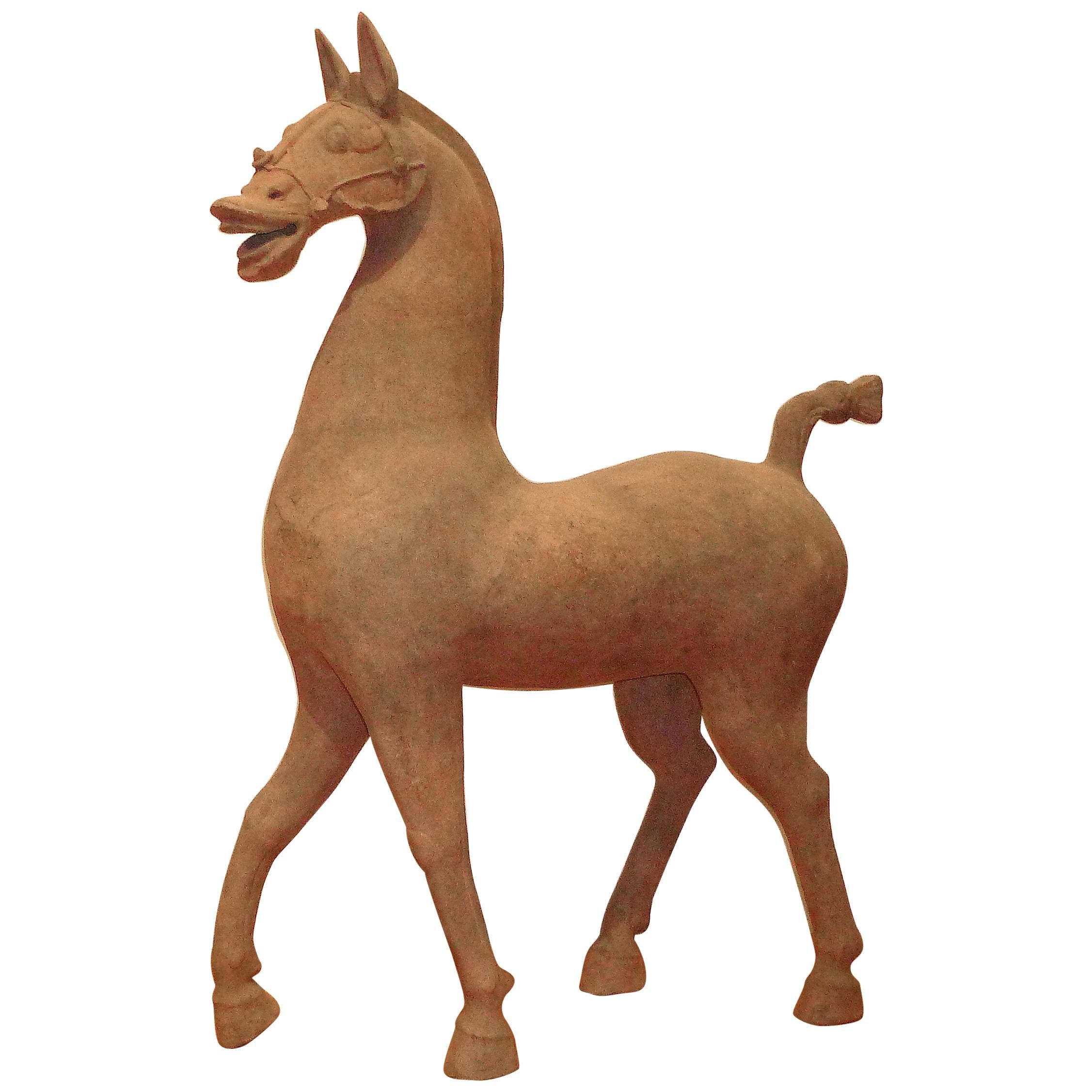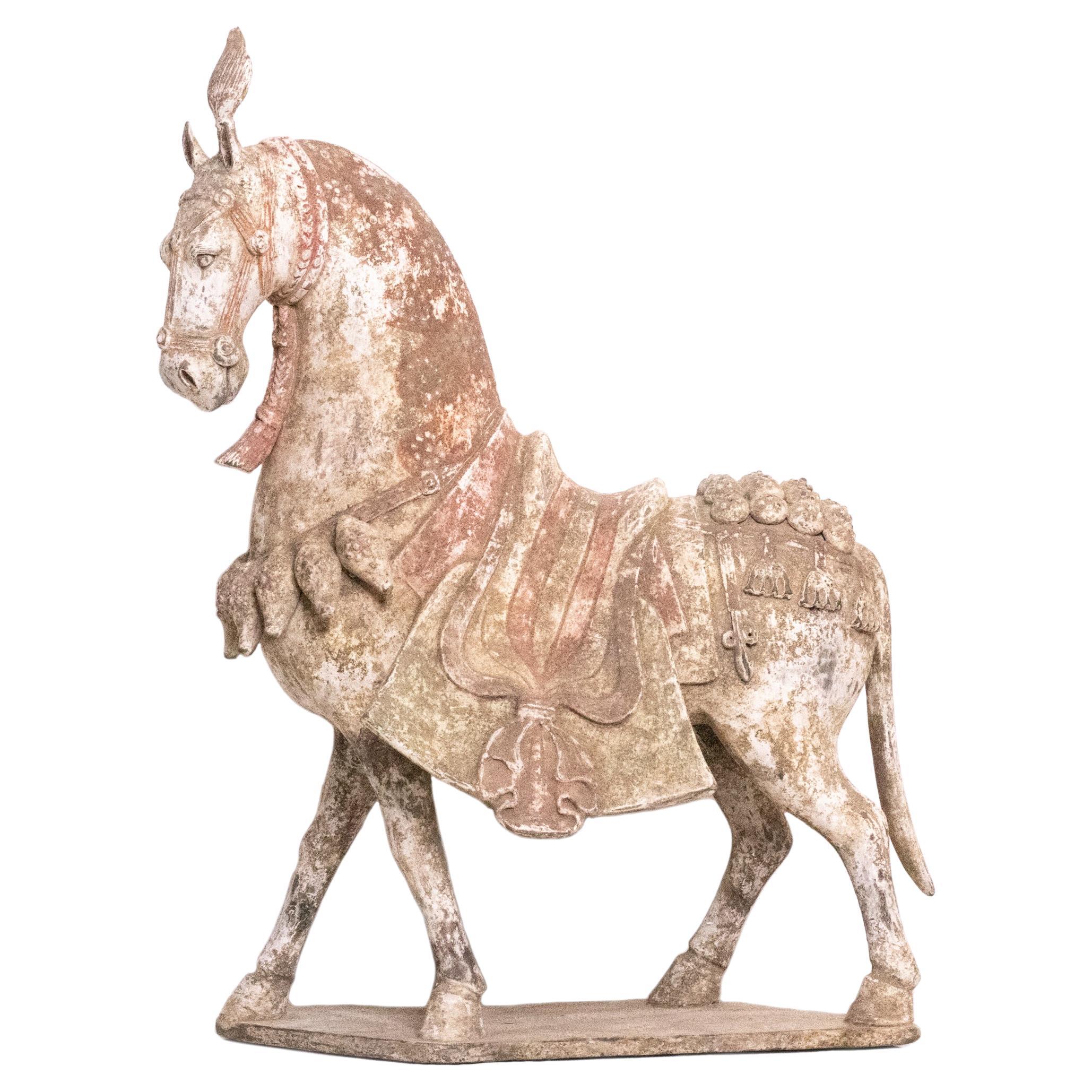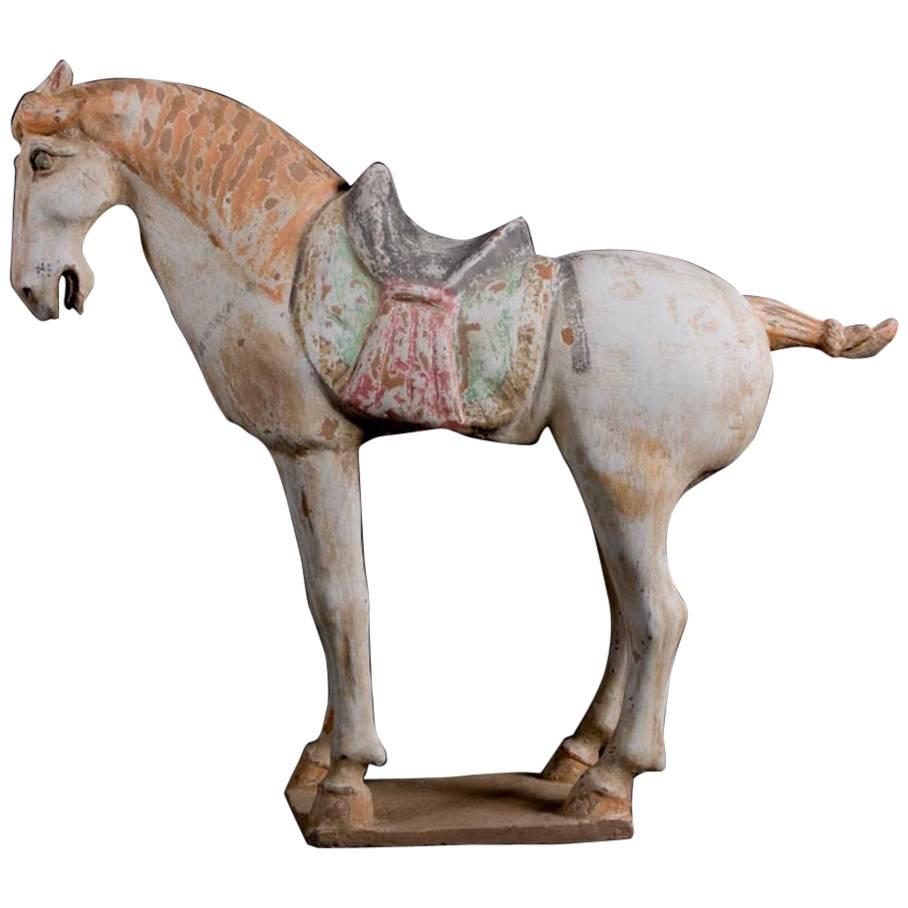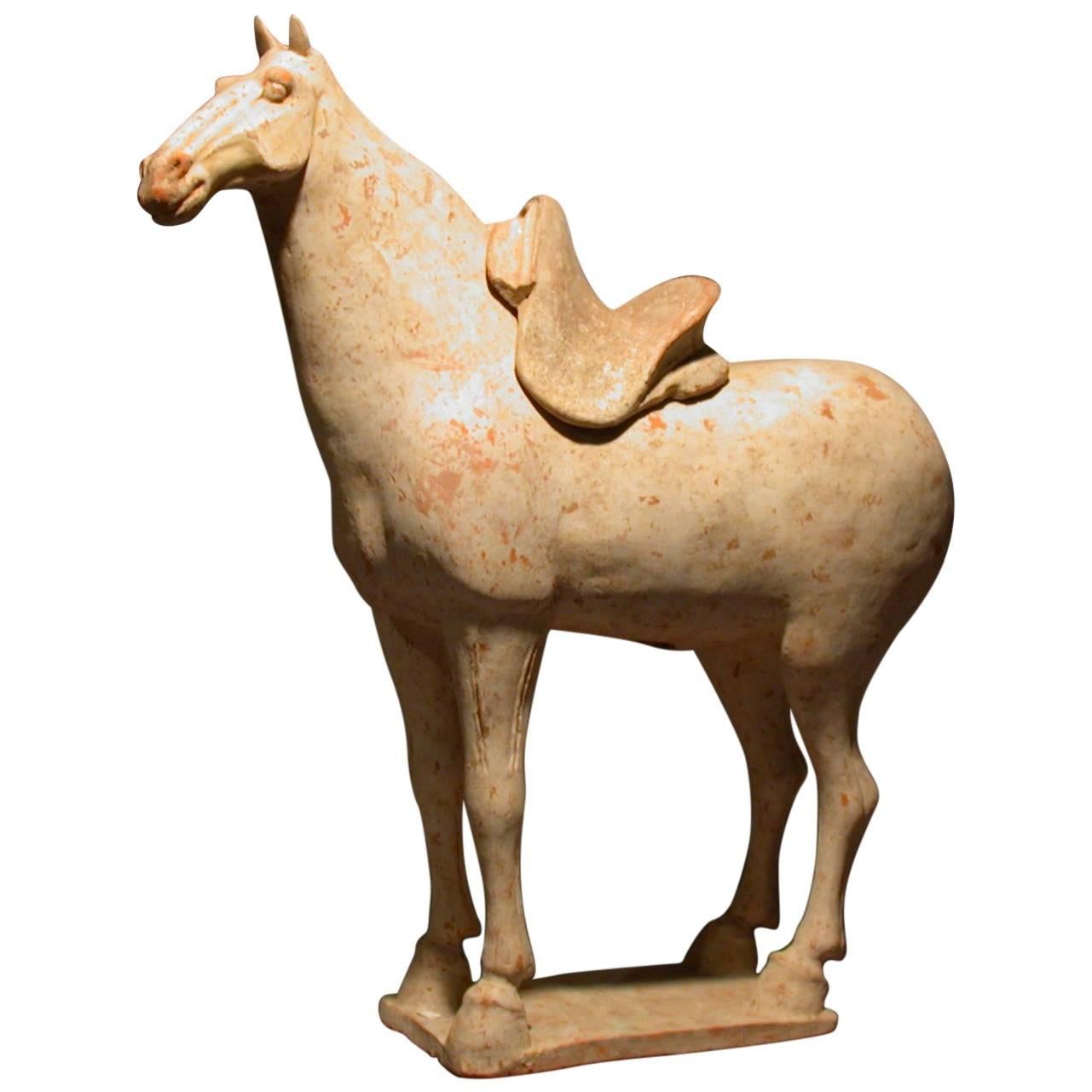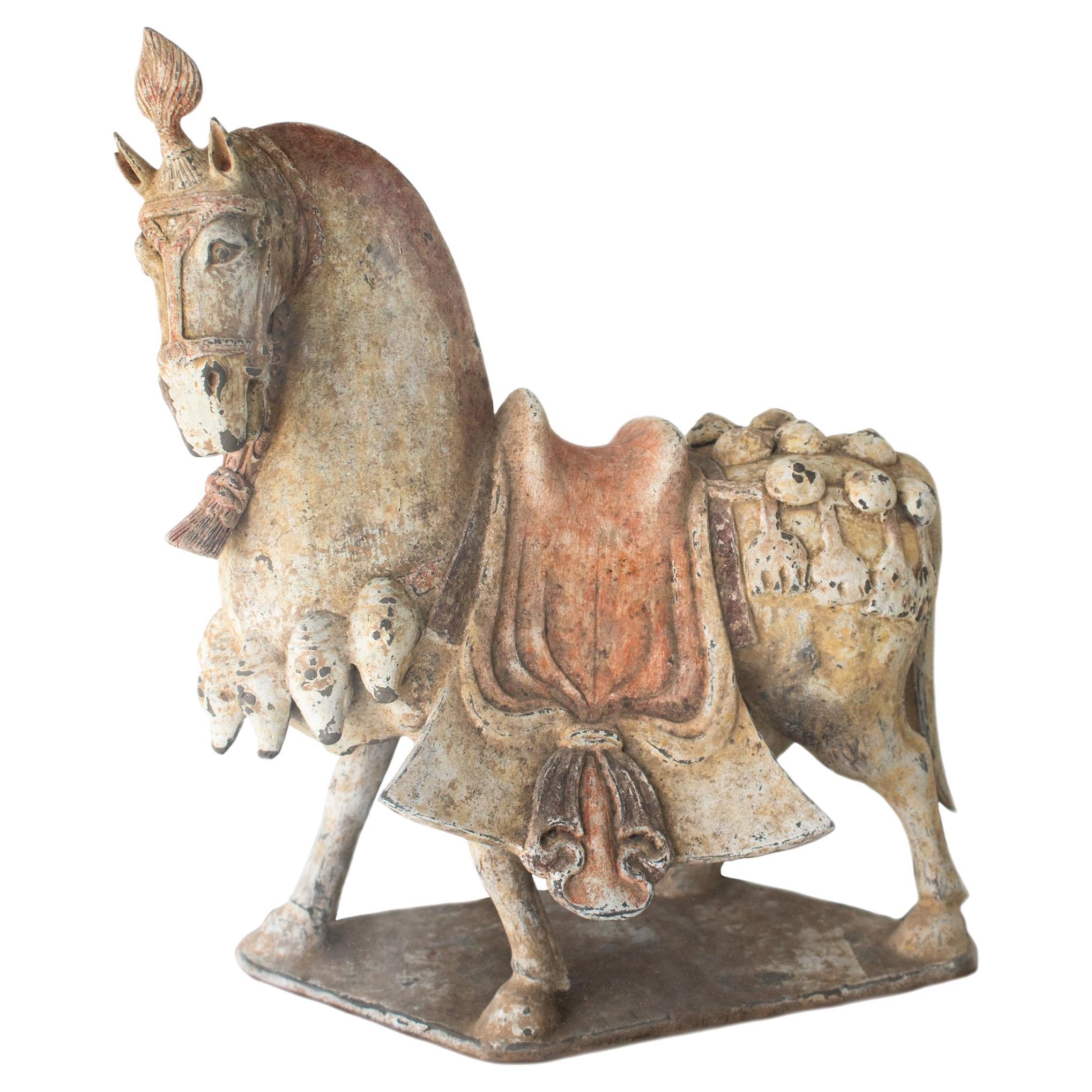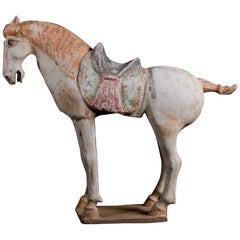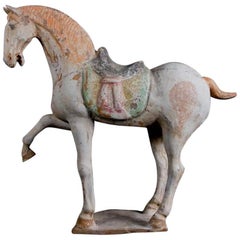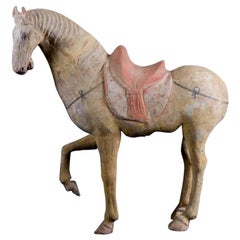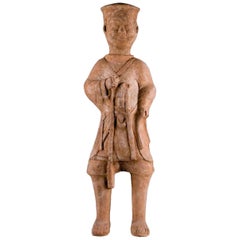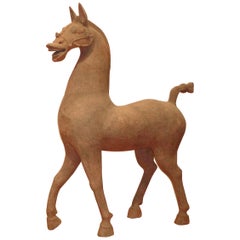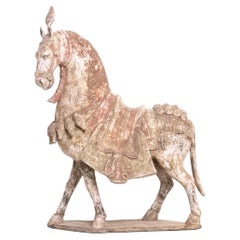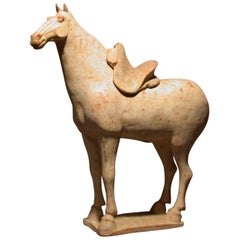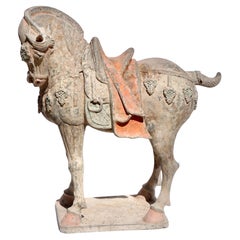Items Similar to Monumental Han Dynasty Terracotta Horse - TL Tested - China, '206 BC–220 AD'
Want more images or videos?
Request additional images or videos from the seller
1 of 10
Monumental Han Dynasty Terracotta Horse - TL Tested - China, '206 BC–220 AD'
$118,750
£90,790.70
€104,572.54
CA$166,405.16
A$185,775.71
CHF 97,343.68
MX$2,274,077.06
NOK 1,236,265.70
SEK 1,165,641.59
DKK 780,435.63
Shipping
Retrieving quote...The 1stDibs Promise:
Authenticity Guarantee,
Money-Back Guarantee,
24-Hour Cancellation
About the Item
A massive pottery horse with separately made head and tail, standing on all fours and striding with its right hoof forward. Extended snout ends in parted lips showing teeth beneath in a braying attitude. Low relief bridle on face and well defined eyes. Raised mane down back of the neck. Reassembled from mostly large fragments with restoration over the break-lines and some new fill. A fantastic example of the Han Dynasty Horse, during this period the prized horse came from the Ferghama Valley in Central Asia, now Afghanistan.
Large, exquisite walking Ferghana horses with great attention paid to anatomical detail were the choice of the wealthy. The horse was second only in importance to the dragon. It was supposed to possess magical powers which the early Chinese were eager to explore. It would be the horse that would carry the deceased to the next life and it would be the amount of horses that an individual owned that would guarantee his ongoing status in the hereafter.
Impressive Museum Masterpiece. Private NYC Collection.
Thermoluminescence certificate from Oxford Labs included.
The Han dynasty was the second imperial dynasty of China (206 BC–220 AD), preceded by the Qin dynasty (221–206 BC).
Spanning over four centuries, the Han period is considered a Golden Age in Chinese history. To this day, China's majority ethnic group refers to themselves as the "Han people”.
The emperor was at the pinnacle of Han society. He presided over the Han government but shared power with both the nobility and appointed ministers who came largely from the scholarly gentry class.
Around the turn of the millennium, Han tomb architectural styles morphed from pits into multi-chambered underground dwellings, often with elaborate carvings and wall paintings. Many shrines in turn were covered with low-relief carvings depicting paradises and stories underscoring Confucian virtues like filial piety and loyalty.
The shrines and spirit paths became an important way for the living to proclaim the deceased family member’s and their own commitment to Confucian values.
Ultimately, funerary objects such as mingqi worked in concert with other funerary objects, tomb architecture, shrines, and spirit-road sculptures to achieve a goal that exceeded the well-being of the family.
According to Confucian doctrine, when every person performed their prescribed social role to perfection, the cosmos would achieve harmony. By ensuring the well-being of the dead, the living promoted accord in the celestial realm and in their own terrestrial existence.
- Dimensions:Height: 43 in (109.22 cm)Width: 37 in (93.98 cm)Depth: 12 in (30.48 cm)
- Style:Han (Of the Period)
- Materials and Techniques:
- Place of Origin:
- Period:
- Date of Manufacture:206 BC-220 AD
- Condition:Wear consistent with age and use. Reassembled from mostly large fragments with restoration over the break-lines and some new fill.
- Seller Location:San Pedro Garza Garcia, MX
- Reference Number:Seller: CH-0891stDibs: LU317239218301
About the Seller
3.7
Vetted Professional Seller
Every seller passes strict standards for authenticity and reliability
1stDibs seller since 2017
24 sales on 1stDibs
Typical response time: 1 to 2 days
- ShippingRetrieving quote...Shipping from: San Pedro Garza Garcia, Mexico
- Return Policy
Authenticity Guarantee
In the unlikely event there’s an issue with an item’s authenticity, contact us within 1 year for a full refund. DetailsMoney-Back Guarantee
If your item is not as described, is damaged in transit, or does not arrive, contact us within 7 days for a full refund. Details24-Hour Cancellation
You have a 24-hour grace period in which to reconsider your purchase, with no questions asked.Vetted Professional Sellers
Our world-class sellers must adhere to strict standards for service and quality, maintaining the integrity of our listings.Price-Match Guarantee
If you find that a seller listed the same item for a lower price elsewhere, we’ll match it.Trusted Global Delivery
Our best-in-class carrier network provides specialized shipping options worldwide, including custom delivery.More From This Seller
View AllStunning Terracotta Standing Horse, Tang Dynasty, China '618-907 AD', TL Test
Located in San Pedro Garza Garcia, Nuevo Leon
Magnificent standing horse in orange terracotta and traces of painting. With a finely decorated saddle and with the mane and tail hair braided. TL Test by Ralph Kotalla Lab NE: 09K12...
Category
Antique 15th Century and Earlier Chinese Tang Antiquities
Materials
Terracotta
Majestic Prancing Horse, Tang Dynasty, China '618-907 AD', TL Test by Kotalla
Located in San Pedro Garza Garcia, Nuevo Leon
Magnificent prancing horse in orange terracotta with traces of polychrome paint. Springing its right leg with a lively position and an expressive look. With a finely decorated saddle...
Category
Antique 15th Century and Earlier Chinese Tang Antiquities
Materials
Terracotta
Magnificent Tang Dynasty Prancing Horse, TL Test by ASA Francine Maurer
Located in San Pedro Garza Garcia, Nuevo Leon
Magnificent Prancing Horse in Orange Terracotta with Traces of Yellow Painting. With its Anterior right Leg raised. TL Test by ASA Francine Maurer Laboratory. It was during the "gol...
Category
Antique 15th Century and Earlier Chinese Tang Antiquities
Materials
Terracotta
Han Dynasty Standing Horse Trainer “Palafrenieri”
Located in San Pedro Garza Garcia, Nuevo Leon
Huge hollow molded terracotta, standing male figure wearing a hip-length multi-layered robe with a collared neck. Implements suspended from his waist, holding a staff in his right ha...
Category
Antique 15th Century and Earlier Han Antiquities
Materials
Terracotta
Elegant Han Dynasty Terracotta Warrior - China '206 BC - 220 AD'
Located in San Pedro Garza Garcia, Nuevo Leon
Impressive terracotta warrior representing a banner bearer gripping a wooden staff with his hands (dematerialized through the ages); his gaze is ser...
Category
Antique 15th Century and Earlier Chinese Han Antiquities
Materials
Terracotta
Chimera (Pixiu) Terracotta Mythological Being - Tang Dynasty, China '618-907 AD'
Located in San Pedro Garza Garcia, Nuevo Leon
Magnificent Mythological Being "Chimera" with Human Face and Flaming Rays Halo. Orange Terracotta with Traces of Stucco and Painting.
This creature is commonly known as Pixiu. Fierc...
Category
Antique 15th Century and Earlier Chinese Tang Antiquities
Materials
Terracotta
You May Also Like
Massive Chinese Han Dynasty Sichuan Terracotta Pottery Horse, Oxford TL Tested
Located in Greenwich, CT
A massive Chinese Han dynasty Sichuan terracotta pottery figure of a horse
Han dynasty (206 BC-220 AD)
Powerfully modelled in a pose of alert attention, its strong neck and head po...
Category
Antique 15th Century and Earlier Chinese Han Sculptures and Carvings
Materials
Terracotta
China 549-577 AD Northern Qi Dynasty Ancient Caparisoned Horse in Earthenware
Located in Miami, FL
Extremely rare Chinese pottery caparisoned horse from the Northern Qi region.
A beautiful large sculptural piece, created in China during the Northern Qi dynasty period, between the 549 and 577 AD. This horse statue is extremely finely modeled of earthenware pottery, standing in a very elegant and majestic position striding on a trapezoidal shaped base.
The animal has a gracefully arched neck to the left looking forward and its extremely well modeled. The head is adorned with a large detailed tassels of plumes and the body is embellished with a beautiful saddle and intricate harnesses. The trapping around the chest and rump is adorned with elaborated tassels and the straps are accented with multiples florets and bosses in high relief. Decorated with dotted and circles patterns.
The surface is treated with applications of natural color pigments such; red, white and others.
Has a measurements of 435 mm by 319 mm by 243 mm (17.10 x 12.55 x 9.55 Inches) (43.5 x 31.9 x 24.3 Cm).
Northern Qi, was the successor state of the Chinese Xianbei state of Eastern Wei...
Category
Antique 15th Century and Earlier Chinese Archaistic Antiquities
Materials
Earthenware, Clay, Paint
$30,280 Sale Price
20% Off
Fine Tang Dynasty Pottery Horse, Oxford TL Tested
Located in Greenwich, CT
Tang dynasty pottery statue of standing horse with removable saddle, Tang dynasty 618-907, come with Oxford authentication TL test certificate. Oxford test num...
Category
Antique 15th Century and Earlier Chinese Tang Sculptures and Carvings
Materials
Terracotta
Tang Dynasty Large And Important Pottery Horse TL Tested
Located in Dallas, TX
Large And Important Tang Dynasty (618-907AD) Pottery Horse TL Tested. China.
Ca. 618-907 AD A beautiful pottery figure of a horse. The animal is shown in a...
Category
Antique 15th Century and Earlier Tang Animal Sculptures
Materials
Pottery
China 549-577 AD Northern Qi Dynasty Ancient Caparisoned Horse In Earthenware
Located in Miami, FL
Exceedingly rare Chinese pottery caparisoned horse from the Northern Qi region.
A beautiful sculptural piece, created in China during the Northern Qi dynasty period, between the 549 and 577 AD. This horse statue is extremely finely modeled of earthenware pottery, standing in a very elegant and majestic position striding on a trapezoidal shaped base.
The animal has a gracefully arched neck to the left and its extremely well modeled. The head is adorned with a large detailed tassels of plumes and the body is embellished with a beautiful saddle and intricate harnesses. The trapping around the chest and rump is adorned with elaborated tassels and the straps are accented with multiples florets and bosses in high relief.
The surface is treated with applications of natural pigments such; red, white and others.
Has a measurements of 394 mm by 343 mm by 257 mm (15.53 x 13.52 x 10.15 Inches) (39.4 x 34.3 x 25.7 Cm).
Northern Qi, was the successor state of the Chinese Xianbei state of Eastern Wei...
Category
Antique 15th Century and Earlier Chinese Archaistic Sculptures and Carvings
Materials
Earthenware, Pottery
$31,988 Sale Price
20% Off
Terracotta Clay Horse Sculpture
By Tang Dynasty
Located in Dallas, TX
A handcrafted terracotta horse in the style of the Tang Dynasty sculptural tradition.
Much of the body of the piece is glazed with a dark indigo blue finish. Some fading in detai...
Category
Late 20th Century Chinese Tang Animal Sculptures
Materials
Terracotta
